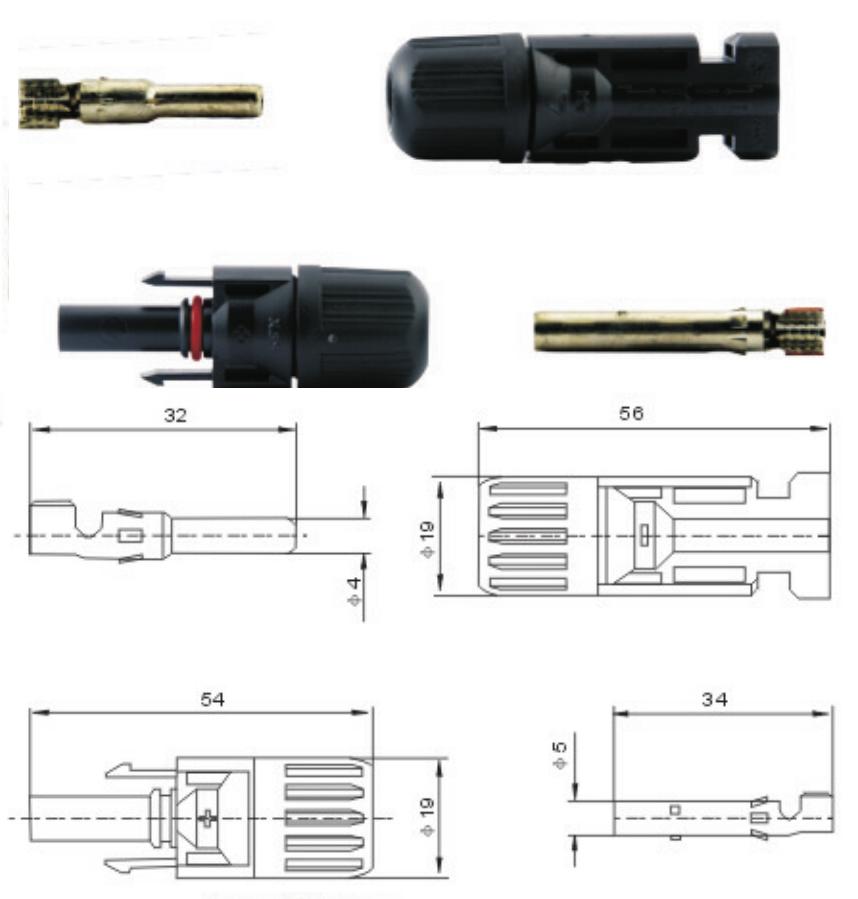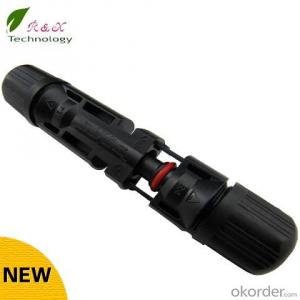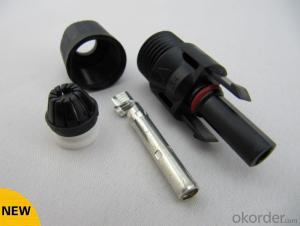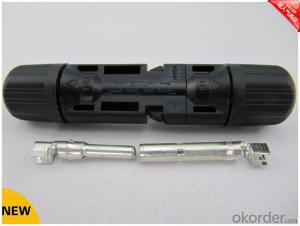MC4 connector on pv system station
- Loading Port:
- Guangzhou
- Payment Terms:
- TT OR LC
- Min Order Qty:
- 100 set
- Supply Capability:
- 50000 set/month
OKorder Service Pledge
OKorder Financial Service
You Might Also Like
Brief introductions of product:
Connector RH4 System for photovoltaic adopts contact and insertion of reed with inner-knob type.It is used with male and famale points.pv junction box and cables made of elastomeric material and makes contact and isertion more certified by IEC61215 and TUV 2PFG1161.
Mainly parameters of product:
Rated voltage 1000V DC
Rated current 30A
Test volaage 6KV(50HZ,1min.)
Ambient temperaure range -40°C...+90°C
Upper limiting temperature 105°C
Degree of protection,mated IP67
unmated IP2X
Contact resistance of plug connectors 0.5m?
Safety class II
Contact system R4 Multilam
Type of termination Crimping
Contact material
Copper,tin plated
Locking system Snap-in(R4)
Cable type PV-F 1169 1*4mm2
1*6mm2
Design paper of product:


- Q:How do solar energy systems impact energy consumption patterns?
- Solar energy systems have a significant impact on energy consumption patterns by reducing reliance on traditional fossil fuel sources. These systems generate clean and renewable energy, thereby reducing greenhouse gas emissions and mitigating the harmful effects of climate change. Additionally, solar energy encourages a shift towards decentralized energy production and encourages individuals and businesses to become more mindful of their energy consumption, leading to greater energy efficiency and conservation.
- Q:Can solar energy systems be used for powering telecommunications networks?
- Yes, solar energy systems can indeed be used for powering telecommunications networks. Solar power is a sustainable and renewable energy source that can be harnessed to generate electricity for various applications, including powering telecommunication infrastructure. Solar energy systems consist of solar panels that convert sunlight into electricity through the photovoltaic (PV) effect. These PV panels are typically installed on rooftops, ground-mounted arrays, or even integrated into the structure of telecommunication towers. They absorb sunlight during the day and convert it into direct current (DC) electricity. To utilize this electricity for powering telecommunications networks, an inverter is used to convert the DC electricity into alternating current (AC), which is the standard form of electricity used in most electronic devices. The AC electricity generated by solar panels can then be used to power telecommunication equipment such as base stations, antennas, transmitters, and receivers. The benefits of using solar energy systems for powering telecommunications networks are numerous. Firstly, solar energy is abundant and available in almost all geographical locations, making it a viable option for powering remote or off-grid telecommunication sites. This reduces the reliance on traditional grid electricity, which may not be available or reliable in certain areas. Secondly, solar power is environmentally friendly, emitting zero greenhouse gases during operation. By using solar energy, telecommunication networks can significantly reduce their carbon footprint and contribute to the global transition towards clean energy sources. Moreover, solar energy systems are low maintenance and have a long lifespan, providing a reliable and cost-effective solution for powering telecommunication infrastructure. Once installed, solar panels require minimal maintenance and can last for 25-30 years or even longer with proper care. In conclusion, solar energy systems can be effectively used for powering telecommunications networks. They offer a sustainable and reliable source of electricity, reduce environmental impact, and provide a cost-effective solution for remote or off-grid telecommunication sites. With the increasing focus on renewable energy, solar power is becoming an increasingly popular choice for powering various sectors, including telecommunications.
- Q:How do solar energy systems impact the health of the population?
- Solar energy systems have a positive impact on the health of the population. They help reduce air pollution by replacing fossil fuel-based power generation, which leads to improved air quality and decreased respiratory ailments. Additionally, solar energy systems do not emit harmful greenhouse gases, reducing the risk of climate-related health issues such as heat strokes and vector-borne diseases. By providing clean and sustainable energy, solar systems contribute to a healthier and more sustainable future for all.
- Q:Can a solar energy system be installed in an apartment or rental property?
- Yes, a solar energy system can be installed in an apartment or rental property. However, there are a few considerations to keep in mind. Firstly, you need to check with your landlord or property owner to see if they are open to the idea of installing a solar energy system. Some landlords may be supportive of green initiatives and may even be willing to help with the installation costs. Others may have restrictions in place, so it is important to have a conversation with them before proceeding. Secondly, the feasibility of installing a solar energy system in an apartment or rental property will depend on the availability of suitable space for solar panels. In most cases, this would be the rooftop of the building. If the rooftop is shared among multiple tenants, you will need to discuss with them and obtain their consent as well. Additionally, it is important to consider the legal and financial aspects. You may need to consult with a solar energy contractor to assess the technical feasibility and cost of installation. Furthermore, you should investigate the laws and regulations in your area regarding solar installations on rental properties, as there may be specific requirements or permissions needed. Lastly, if you are a tenant, you need to consider the length of your lease. Installing a solar energy system is a long-term investment, and it may not be financially viable if you plan to move out before the system has paid for itself through energy savings. In summary, while it is possible to install a solar energy system in an apartment or rental property, it is important to have open communication with your landlord, consider the availability of suitable space, evaluate the legal and financial aspects, and consider the length of your lease before proceeding.
- Q:Can solar energy systems be installed on roofs?
- Yes, solar energy systems can be installed on roofs. In fact, rooftops are one of the most common locations for installing solar panels. The main advantage of installing solar panels on roofs is that they utilize the existing space without requiring any additional land. Rooftop solar installations are also advantageous because they are usually unobstructed by shading from trees or buildings, resulting in optimal sun exposure for generating electricity. Additionally, rooftop installations are often cost-effective as they can reduce the need for long-distance transmission lines and can directly supply power to the building they are installed on. Overall, installing solar energy systems on roofs is a practical and efficient way to harness clean and renewable energy.
- Q:Can solar energy systems be used for powering industrial manufacturing plants?
- Yes, solar energy systems can be used for powering industrial manufacturing plants. In fact, many industrial manufacturing plants across the world are already utilizing solar energy systems to reduce their reliance on fossil fuels and decrease their environmental impact. Solar energy systems consist of photovoltaic (PV) panels that convert sunlight into electricity. These panels can be installed on the roofs or open spaces of manufacturing plants to harness the abundant solar energy. The electricity generated by the solar panels can be used to power various processes and equipment within the industrial plant, such as machinery, lighting, heating, ventilation, and air conditioning systems. The use of solar energy for powering industrial manufacturing plants offers numerous benefits. Firstly, solar power is a renewable and clean source of energy, which helps reduce greenhouse gas emissions and dependence on fossil fuels. This aligns with the growing need for sustainable practices and reducing the carbon footprint of industries. Secondly, solar energy systems can significantly reduce electricity costs for manufacturing plants. Once the initial investment is made to install the solar panels, the operational costs are relatively low. Additionally, some countries offer incentives and subsidies for implementing solar energy systems, further reducing the financial burden. Moreover, solar energy systems can provide a stable and reliable source of electricity. With advancements in battery storage technology, excess solar energy can be stored and used during non-sunlight hours or in times of high demand. This helps ensure uninterrupted power supply and reduces the reliance on the grid. However, it is important to note that the feasibility of using solar energy systems for powering industrial manufacturing plants depends on various factors, such as the availability of sunlight, the size of the plant, energy requirements, and the initial investment cost. Additionally, some manufacturing processes may require a consistent and higher level of electricity that may not be fully met by solar energy alone. Overall, solar energy systems have proven to be a viable and sustainable option for powering industrial manufacturing plants. Their use can contribute to reducing carbon emissions, lowering electricity costs, and promoting a greener and more environmentally friendly industrial sector.
- Q:How do solar energy systems affect the grid?
- Solar energy systems can have both positive and negative effects on the grid. On the positive side, when solar panels generate excess electricity, it can be fed back into the grid, reducing the demand for energy from traditional power plants. This can help in reducing the overall carbon footprint and reliance on fossil fuels. However, the intermittency of solar power can pose challenges. When solar production drops due to weather conditions or at night, the grid must compensate by relying on other energy sources, which can strain the system and require additional infrastructure investments. Nevertheless, with proper planning, grid integration, and energy storage solutions, solar energy systems can contribute to a more sustainable and resilient grid.
- Q:Can solar energy systems be used for powering water pumps in rural areas?
- Yes, solar energy systems can definitely be used for powering water pumps in rural areas. Solar-powered water pumping systems are increasingly being used in remote areas where access to electricity is limited or expensive. These systems use solar panels to capture sunlight and convert it into electricity, which is then used to power the water pumps. This sustainable and renewable energy solution is cost-effective, environmentally friendly, and can provide a reliable source of water for agricultural, domestic, and irrigation purposes in rural communities.
- Q:Can a solar energy system be installed on a parking garage or structure?
- Yes, a solar energy system can be installed on a parking garage or structure. In fact, parking garages and structures are often ideal locations for solar panel installations due to their large, open areas and unobstructed access to sunlight. Installing solar panels on parking structures not only helps to generate clean and renewable energy, but it can also provide shading for parked vehicles, reducing the heat island effect and improving energy efficiency.
- Q:What is the impact of fire on solar panels?
- The impact of fire on solar panels can be quite significant and detrimental. Fires can cause direct damage to the panels, resulting in their complete destruction or rendering them inoperable. The high temperatures generated by fires can melt or warp the delicate components of the solar panels, such as the photovoltaic cells and the wiring. This damage can make the panels incapable of producing electricity. Furthermore, the smoke and soot generated by fires can cover the surface of the solar panels, reducing their efficiency by obstructing sunlight and decreasing the amount of light that can be absorbed. This can lead to a significant reduction in power output from the panels. In addition to the physical damage caused by fires, the heat and flames can also pose a safety risk to the surrounding area. Solar panels are typically installed on rooftops or in open areas, making them vulnerable to fire hazards. If a fire occurs near or on a solar panel, it can increase the risk of the fire spreading and causing further damage to the property. To mitigate the impact of fire on solar panels, it is crucial to have proper fire safety measures in place. This includes using fire-resistant materials for the installation of solar panels and ensuring that the panels are adequately protected from potential fire sources. Regular maintenance and cleaning of the panels are also essential to remove any debris or soot that may accumulate, thus maximizing their efficiency and minimizing the risk of damage in the event of a fire. Overall, the impact of fire on solar panels can be severe, leading to physical damage, decreased efficiency, and safety risks. It is crucial to take necessary precautions and implement fire safety measures to protect solar panels and minimize potential losses.
1. Manufacturer Overview |
|
|---|---|
| Location | |
| Year Established | |
| Annual Output Value | |
| Main Markets | |
| Company Certifications | |
2. Manufacturer Certificates |
|
|---|---|
| a) Certification Name | |
| Range | |
| Reference | |
| Validity Period | |
3. Manufacturer Capability |
|
|---|---|
| a)Trade Capacity | |
| Nearest Port | |
| Export Percentage | |
| No.of Employees in Trade Department | |
| Language Spoken: | |
| b)Factory Information | |
| Factory Size: | |
| No. of Production Lines | |
| Contract Manufacturing | |
| Product Price Range | |
Send your message to us
MC4 connector on pv system station
- Loading Port:
- Guangzhou
- Payment Terms:
- TT OR LC
- Min Order Qty:
- 100 set
- Supply Capability:
- 50000 set/month
OKorder Service Pledge
OKorder Financial Service
Similar products
New products
Hot products
Related keywords
































